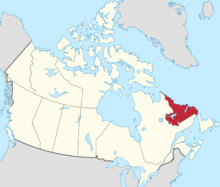Labrador (Canada)
Labrador is part of the Province of Newfoundland and Labrador , Canada , and is located on the Labrador Peninsula (also known as Ungava-Labrador ).
Labrador has an area of 294,330 km² and is about the size of Italy. The population was 27,197 in 2016, around 30% of which were indigenous ( Inuit , Innu and Métis ).
The name "Labrador" is one of the oldest names of European origin in Canada, much older than the name "Newfoundland". Probably a member of the John Cabot crew took over the word "llavrador" from the Azores . Portuguese Terra de Lavrodores (formerly also called “slave coast”), named after 57 slaves brought with them in 1501, is derived from lavradores (“workers”). According to another explanation, the name goes back to the Portuguese navigator João Fernandes Lavrador .
Geography and climate
Most of Labrador is made up of tundras and forest tundras . Around 25% of the area is taken up by lakes , streams and rivers . The climate is partly arctic , partly sub-arctic .
history
Until 1763, Labrador was part of the French colony of New France . Then it fell in the Seven Years' War to the British colony of Newfoundland and in 1774 with Anticosti and the Magdalene Islands to the British colony of Québec (now Ontario and Québec ). The Herrnhuter Brothers Congregation has been doing missionary work among the Inuit natives since 1760 and founded the villages of Hoffnungstal ( Hopedale ), Makkovik , Nain and Hebron . In 1791 Québec was divided into the provinces of Upper and Lower Canada , Labrador came to Lower Canada. In 1809 Labrador came back to Newfoundland (from Cape Chidley to the mouth of the Romaine River ). The northern area of the Gulf of Saint Lawrence west of Blanc-Sablon was separated from Labrador in 1925 at the 52nd parallel north and came back to Canada (Newfoundland was a separate Dominion at that time ). Further border disputes ( Labrador border conflict ) were settled by a court ruling in 1927. In 1949, Newfoundland joined the Canadian state, founded in 1867, and became a province. This province changed its name from Newfoundland to Newfoundland and Labrador in 2001 .
During the Second World War , U 537 built the unmanned German weather radio station Kurt in Atti-naukjuke Bay, now called Martin Bay , on October 23, 1943 . This station was searched for in the summer of 1981 on the basis of papers that were at Siemens , and remains of it were found.
Web links
- Project Gutenberg e-text from Dillon Wallace's The Lure of the Labrador Wild
- German weather radio station from World War II on Labrador
Individual evidence
- ^ Johann Jakob Egli : Nomina geographica. Language and factual explanation of 42,000 geographical names of all regions of the world. Friedrich Brandstetter, 2nd edition, Leipzig 1893, p. 519
- ↑ Labrador Boundary Dispute ( English, French ) In: The Canadian Encyclopedia . Retrieved July 28, 2019.

